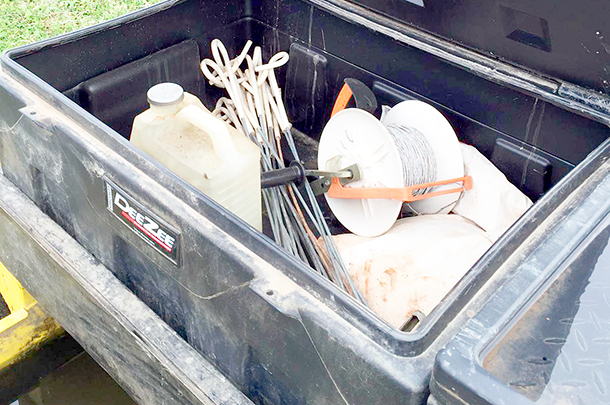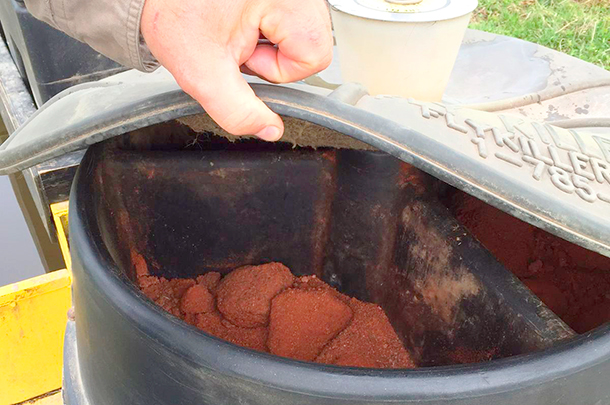With 150 acres split into three different sections, he needed a simple way to haul water and everything else needed in his rotational grazing system. Thus, the idea of the water wagon was born.
Through the assistance of conservation cost-sharing programs and a college degree in engineering that definitely came in handy, he was able to craft a one-of-a-kind water/mineral/tool trailer built to haul 600 gallons of water, fencing supplies and about 12 bags of mineral.
He says, “I was taking too much time driving back and forth to get fencing supplies, mineral and whatever else I needed. Everything I need for my rotational grazing is in this one compact trailer.”
But how did he do it?
After scrolling through Craigslist one night, Abney came across the trailer that he had been looking for. Thinking he was going to have to build one from scratch, he stumbled across a unique airport luggage cart that had been modified to haul some type of industrial equipment. So he bought the trailer.

With the trailer checked off his list, Abney welded a solid tank – 8 feet long and about 4 feet wide and about 1 foot deep – to the bottom of his new purchase. The tank has about 2 to 3 inches of clearance between the ground and the bottom of the tank, making it easy for calves and older stock to access.
Abney says the trailer is about 10 feet long and 4 feet wide, and the whole bottom of it is the water tank. He added a mineral feeder and two toolboxes to the top of the water tank. The mineral feeder he bought has a rubber lid and a small hood inside that deposits fly control. So every time his cattle stick their head in to get some mineral, they’re rubbing fly control on their forehead and face – again, another convenience, he says.
On top of that, Abney doesn’t have to manually fill up the water tank. With access to water every 175 feet (thanks to cost-share programs), he can hook up a 200-foot pressurized garden hose to the water line and tank. When it’s time to move, he simply drags the hose another 175 feet and attaches it to the line – keeping the water in the tank at a constant and consistent level.
If he didn’t have such easy access to water, Abney says he could fill it up every morning and drag it out there, but he likes to leave it in the pasture and move it with his cattle. Although, he says, “Someone could easily fill it up in the morning, drive it to their animals and then drive it back home to fill it up again.”

For the trailer and all of his add-ons, Abney has about $1,000 and 40 hours invested in the whole project. About one-third of the cost was in the toolboxes. He recommends finding a trailer that is already low to the ground or heavy duty enough to do what you want with it when it’s modified. He says, “You can start from scratch, but it would have cost me a whole lot more to build it from the ground up.”
Overall, Abney is very pleased with his project. He believes anyone could make this compact trailer as long as they have at least “some” fabrication skills. This will be the second year he has used the trailer and so far, it hasn’t let him down.
“I am a one-man show and filling up water tanks and hauling them down into another pasture and stuff like that is a little bit of a problem,” Abney says. “And because of my engineering training and the way my brain works, I try to improve things. If there’s a problem on a piece of equipment you can get someone out to fix it, and I thought that if I could come up with a trailer that could move the water, the tools, the mineral and everything easily, I would have a much better use of my time and my pasture and that’s exactly what has happened.” ![]()
PHOTO 1: Doug Abney standing by his one-of-a-kind water/mineral/tool trailer.
PHOTO 2: The toolboxes keep everything Abney needs for his rotational grazing system in one place.
PHOTO 3: Adding the mineral feeder, that is also a form of fly control, was another convenience for Abney who is currently a one-man show. Photos provided by Doug Abney.

-
Cassidy Woolsey
- Editor
- Progressive Forage
- Email Cassidy Woolsey











